Train Rescheduling for Large Transfer Passenger Flow by Adding Cross-Line Backup Train in Urban Rail Transit
Abstract
:1. Introduction
2. Problem Description
2.1. Basic Assumptions
2.2. Symbol Definition
3. Mathematical Model
3.1. Constraints
- (1)
- Constraints related to train operation
- (2)
- Constraints related to passenger flow calculation
3.2. Objective Function
4. Model Transformation and Solution Approaches
4.1. Model Transformation
4.2. Solution Approaches
- (1)
- Direct approach
- (2)
- Dynamic adjustment approach
- (3)
- Emergency priority approach
5. Computational Experiments
5.1. Experiment Description
5.2. Results and Analysis
6. Discussion
7. Conclusions
Author Contributions
Funding
Institutional Review Board Statement
Informed Consent Statement
Data Availability Statement
Conflicts of Interest
References
- Yang, A.; Wang, B.; Chen, Y.; Huang, J.; Xiong, J. Plan of Cross-line Train in Urban Rail Transit Based on the Capacity Influence. J. Transp. Syst. Eng. Inf. Technol. 2017, 17, 221–227. [Google Scholar]
- Yang, A.; Wang, B.; Huang, J.; Li, C. Service Replanning in Urban Rail Transit Networks: Cross-line Express Trains for Reducing the Number of Passenger Transfers and Travel Time. Transp. Res. Part C 2020, 115, 102629. [Google Scholar] [CrossRef]
- Chen, L.; Duan, X.; Bai, Y. Optimizing Cross-line Train Service Planning in Urban Rail Transit Network. Urban Rapid Rail Transit 2023, 36, 59–64. [Google Scholar]
- Zeng, Q.; Peng, Q. Cross-Line Train Plan in Urban Rail Transit Considering the Multi-Group Train. J. Railw. Sci. Eng. 2023, 20, 878–889. [Google Scholar]
- Huang, J.; Chen, Y.; Zhang, A.; Zhou, Q.; Bai, Y.; Mao, B. Optimization of Urban Rail Network Operation Scheme Considering Interconnection. J. Railw. Sci. Eng. 2023, 20, 1587–1597. [Google Scholar]
- Zhen, Q.; Jing, S. Train Rescheduling Model with Train Delay and Passenger Impatience Time in Urban Subway Network. J. Adv. Transp. 2016, 50, 1990–2014. [Google Scholar] [CrossRef]
- Chu, P.; Yu, Y.; Dong, D.; Yuan, J.; Chen, Y. Train Rescheduling for Urban Rail Transit Considering Replacement and Equilibrium. J. Wuhan Univ. Technol. Transp. Sci. Eng. 2022, 46, 389–393. [Google Scholar]
- Gao, Y.; Kroon, L.; Schmidt, M.; Yang, L. Rescheduling A Metro Line in an Over-Crowded Situation after Disruptions. Transp. Res. Part B 2016, 93, 425–449. [Google Scholar] [CrossRef]
- Wang, Y.; Zhao, K.; D’Ariano, A.; Niu, R.; Li, S.; Luan, X. Real-time Integrated Train Rescheduling and Rolling Stock Circulation Planning for a Metro Line Under Disruptions. Transp. Res. Part B 2021, 152, 87–117. [Google Scholar] [CrossRef]
- Yin, J.; Yang, L.; D’Ariano, A.; Tang, T.; Gao, Z. Integrated Backup Rolling Stock Allocation and Timetable Rescheduling with Uncertain Time-variant Passenger Demand under Disruptive Events. Inf. J. Comput. 2022, 34, 3234–3258. [Google Scholar] [CrossRef]
- Yoo, S.; Kim, H.; Kim, W.; Kim, N.; Lee, J. Controlling Passenger Flow to Mitigate the Effects of Platform Overcrowding on Train Dwell Time. J. Intell. Transp. Syst. 2022, 26, 366–381. [Google Scholar] [CrossRef]
- Song, X.; Feng, X.; Wang, Z.; Huang, W.; Chen, M. Simulation Analysis of Large Inbound Passenger Flow Control Measures of Subway Station Based on Dynamic Path Planning. Transp. Stand. 2022, 8, 154–165. [Google Scholar]
- Shi, J.; Yang, J.; Yang, L. Safety-oriented Cooperative Passenger Flow Control Model in Peak Hours for a Metro Line. J. Transp. Syst. Eng. Inf. Technol. 2019, 19, 125–131. [Google Scholar]
- Li, Y.; He, J.; Peng, Z. Multi-station Passenger Flow Control Problem Considering Early Warning Mechanism and Operation Scheme. J. Railw. Sci. Eng. 2023, 20, 84–93. [Google Scholar]
- Liu, R.; Li, S.; Yang, L. Collaborative Optimization for Metro Train Scheduling and Train Connections Combined with Passenger Flow Control Strategy. Omega 2020, 90, 101990. [Google Scholar] [CrossRef]
- Shi, J.; Yang, L.; Yang, J.; Gao, Z. Service-oriented Train Timetabling with Collaborative Passenger Flow Control on an Oversaturated Metro Line: An Integer Linear Optimization Approach. Transp. Res. Part B 2018, 110, 26–59. [Google Scholar] [CrossRef]
- Li, J.; Bai, Y.; Zhou, Y.; Chen, Z.; Xu, Q. Integrated Model on Inbound Passenger Flow Control and Timetable Regulation at Transfer Station. J. China Railw. Soc. 2020, 42, 9–18. [Google Scholar]
- Yuan, Y.; Li, S.; Yang, L.; Gao, Z. Real-time Optimization of Train Regulation and Passenger Flow Control for Urban Rail Transit Network under Frequent Disturbances. Transp. Res. Part E 2022, 168, 102942. [Google Scholar] [CrossRef]
- Ying, M. Shanghai World Expo and Metro Operation Assurance. Urban Mass Transit 2011, 14, 1–4. [Google Scholar]
- Xiong, Y.; Wei, W. Application and Optimization of Urban Rail Transit Standby Train. Urban Mass Transit 2010, 13, 87–88. [Google Scholar]
- Ye, M.; Qian, Z.; Li, J.; Cao, C. Selection and Optimization Model of Standby Train Deployment Stations on Urban Rail Transit for Large Passenger Flow. J. Traffic Transp. Eng. 2021, 21, 227–237. [Google Scholar]
- Yin, J.; Wang, Y.; Tang, T.; Xun, J.; Su, S. Metro Train Rescheduling by Adding Backup Trains under Disrupted Scenarios. Front. Eng. Manag. 2017, 4, 418–427. [Google Scholar] [CrossRef]
- Wang, Z.; Su, S.; Su, B.; Tang, T. A Metro Train Rescheduling Approach Considering Flexible Short-turning and Adding Backup Trains Strategies during Disruptions in the Case of the Vehicle Breakdown. In Proceedings of the 2021 IEEE International Intelligent Transportation Systems Conference, Indianapolis, IN, USA, 19–22 September 2021. [Google Scholar]
- Wang, Z.; Zhang, X.; Chen, S.; Jian, M.; Chen, Z. A Metro Timetable Rescheduling Optimization Method in Case of Failure Train Rescue. J. Railw. Sci. Eng. 2023. [Google Scholar] [CrossRef]
- Bai, G.; Guo, J.; Shi, H.; Yang, Y.; Zhang, T. Optimization for Transfer Coordination of Network Timetable in Urban Rail Transit. J. China Railw. Soc. 2016, 38, 1–7. [Google Scholar]
- Sun, P.; Zhao, J.; Ding, H. The Optimization of Urban Rail Transit Operation Scheme Based on Coordinated Transfer. Railw. Transp. Econ. 2011, 33, 67–70. [Google Scholar]
- Xu, R.; Liu, B.; Fan, W. Train Operation Adjustment Strategies in Metro Based on Transfer Capacity Coordination. J. Transp. Syst. Eng. Inf. Technol. 2017, 17, 164–170. [Google Scholar]
- Yu, Y.; Chu, P.; Hong, H.; Yuan, J.; Zhao, H. Robustness Comparison of Shanghai Metro Networks from Line Interaction Perspective. Proc. SPIE 2022, 12081, 120812H. [Google Scholar]
- Li, W.; Xu, R.; Zhu, W. Multi-line Cooperation Method for Passenger Flow Disposal in Metro Transfer Station under Train Delay. J. Tongji Univ. Nat. Sci. 2015, 43, 239–244. [Google Scholar]
- Cui, X.; Lu, Q.; Xu, P.; Wang, Z.; Qin, H. Critical Station Identification Based on Node Importance Contribution Matrix in Urban Rail Transit Network. J. Railw. Sci. Eng. 2022, 19, 2524–2531. [Google Scholar]
- Carvajal-Carreño, W.; Cucala, A.P.; Fernández-Cardador, A. Fuzzy Train Tracking Algorithm for the Energy Efficient Operation of CBTC Equipped Metro Lines. Eng. Appl. Artif. Intell. 2016, 53, 19–31. [Google Scholar] [CrossRef]
- Xu, W.; Zhao, P.; Ning, L. A Practical Method for Timetable Rescheduling in Subway Networks during the End-of-Service Period. J. Adv. Transp. 2018, 2018, 5914276. [Google Scholar] [CrossRef]
- Yang, X.; Hu, H.; Yang, S.; Wang, W.; Shi, Z.; Yu, H.; Huang, Y. Train Operation Adjustment Method of Cross-line Train in Urban Rail Transit Based on Coyote Optimization Algorithm. In Proceedings of the 2020 IEEE 23rd International Conference on Intelligent Transportation Systems (ITSC), Rhodes, Greece, 20–23 September 2020. [Google Scholar]
- Wang, Y.; Zhu, S.; D’Ariano, A.; Yin, J.; Miao, J.; Meng, L. Energy-efficient Timetabling and Rolling Stock Circulation Planning Based on Automatic Train Operation Levels for Metro Lines. Transp. Res. Part C 2021, 129, 103209. [Google Scholar] [CrossRef]
- Bemporad, A.; Morari, M. Control of Systems Integrating Logic, Dynamics, and Constraints. Automatica 1999, 35, 407–427. [Google Scholar] [CrossRef]
- Baker, K.R. Computational Results for the Flowshop Tardiness Problem. Comput. Ind. Eng. 2013, 64, 812–816. [Google Scholar] [CrossRef]
- Herrmann, F. Using Optimization Models for Scheduling in Enterprise Resource Planning Systems. Systems 2016, 4, 15. [Google Scholar] [CrossRef]
- Tian, S. Study on Optimization of Train Routing Planning of Urban Rail Transit Considering Congestion Degree of Transfer Station; Beijing Jiaotong University: Beijing, China, 2019. [Google Scholar]
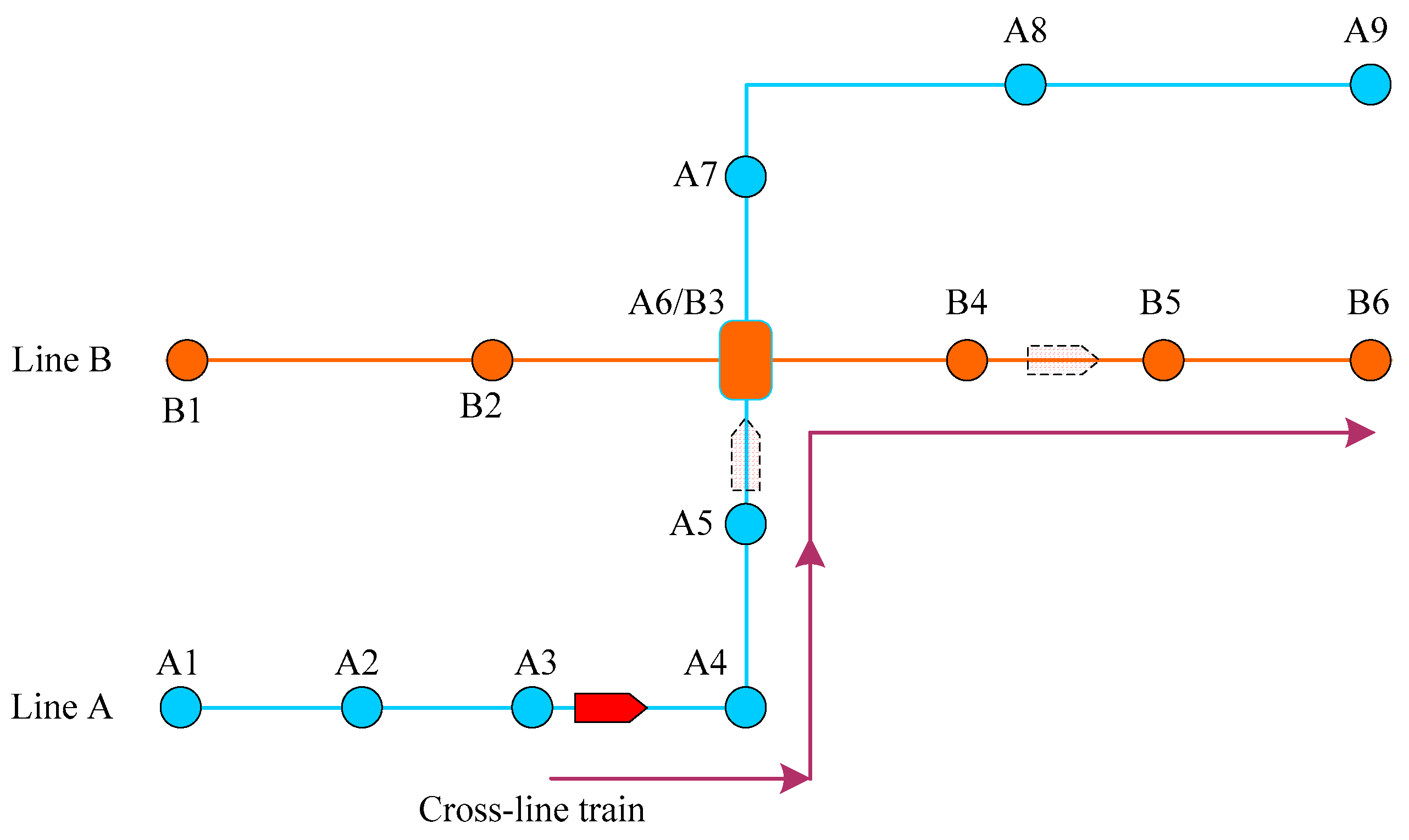
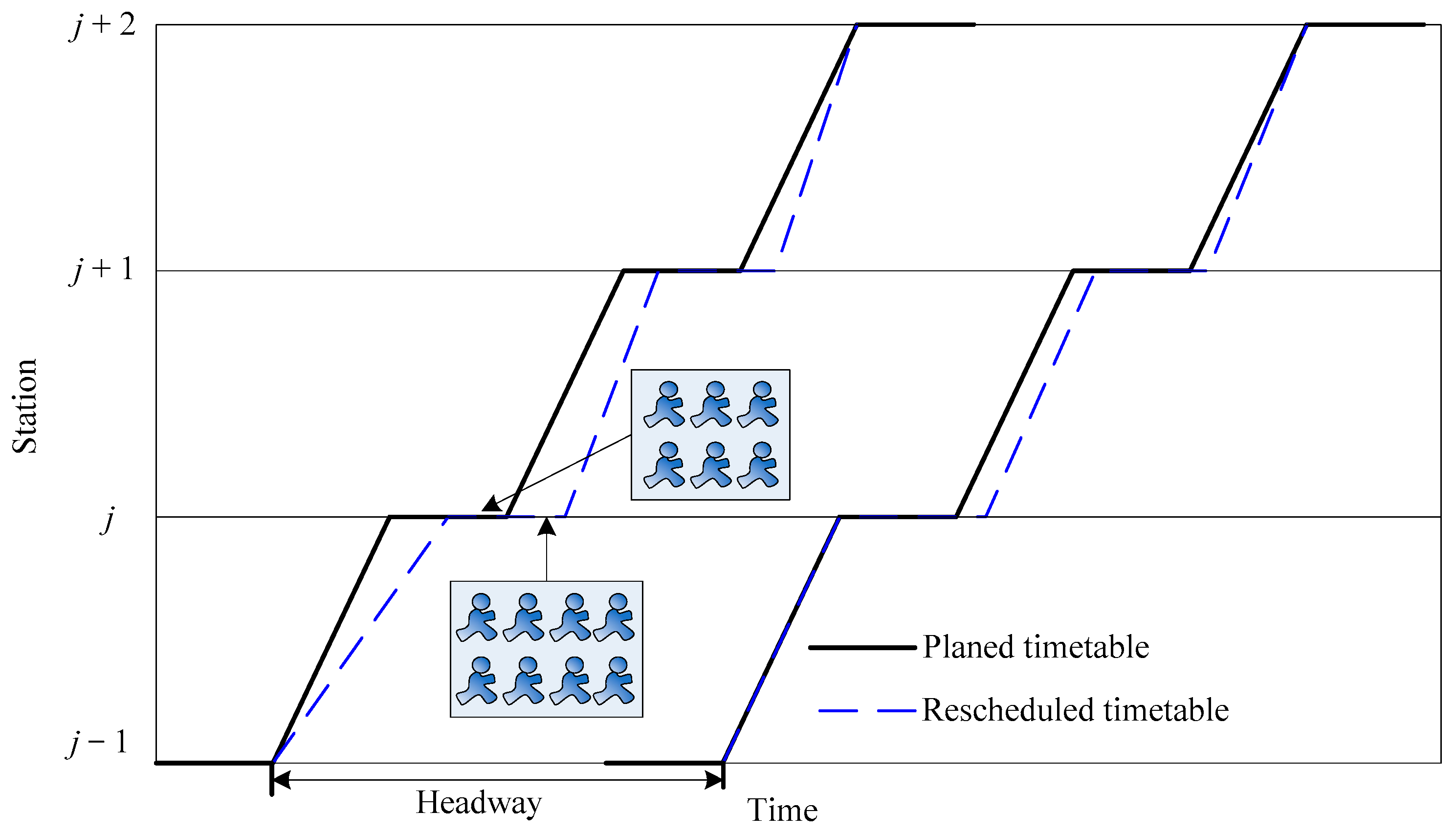
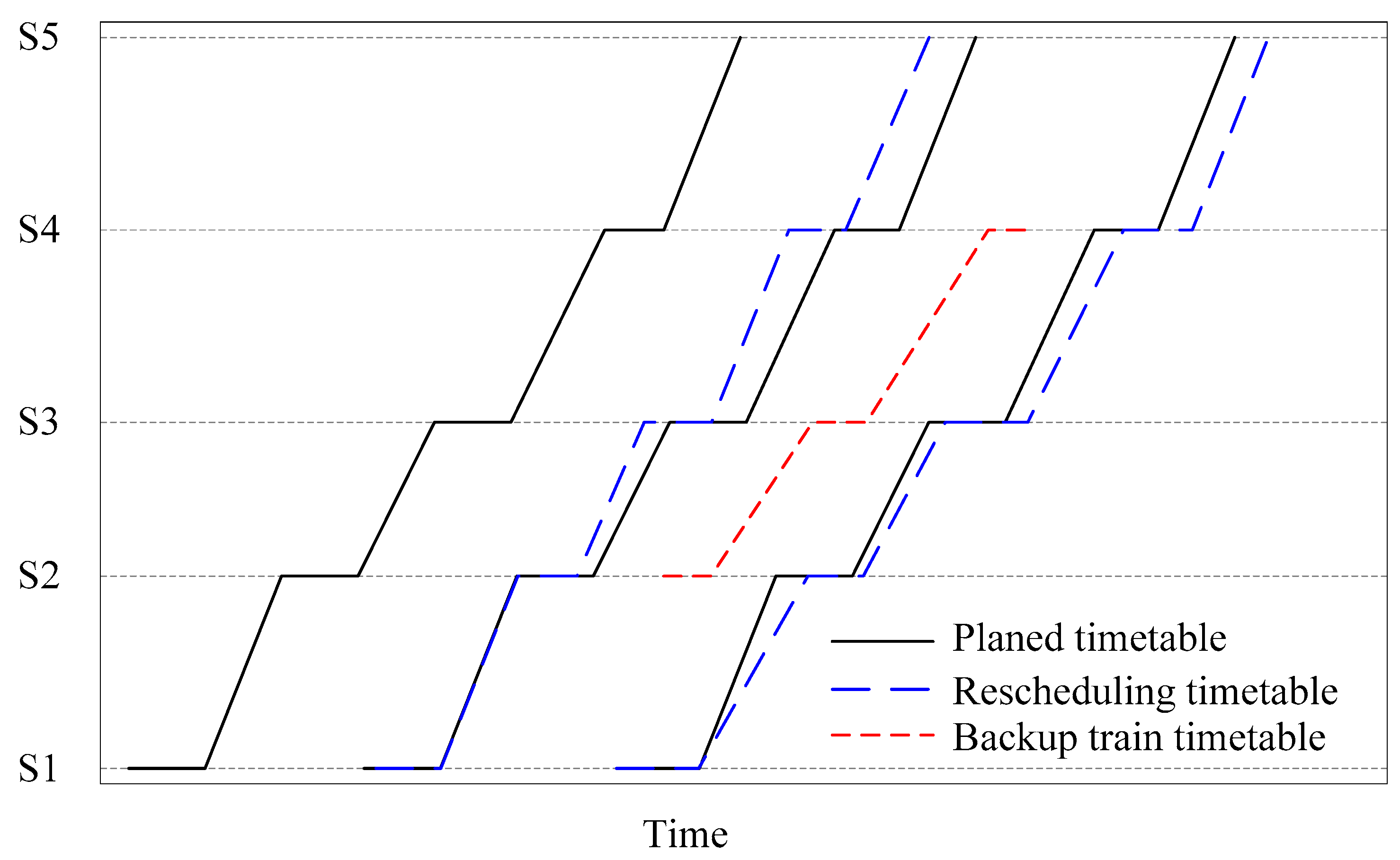
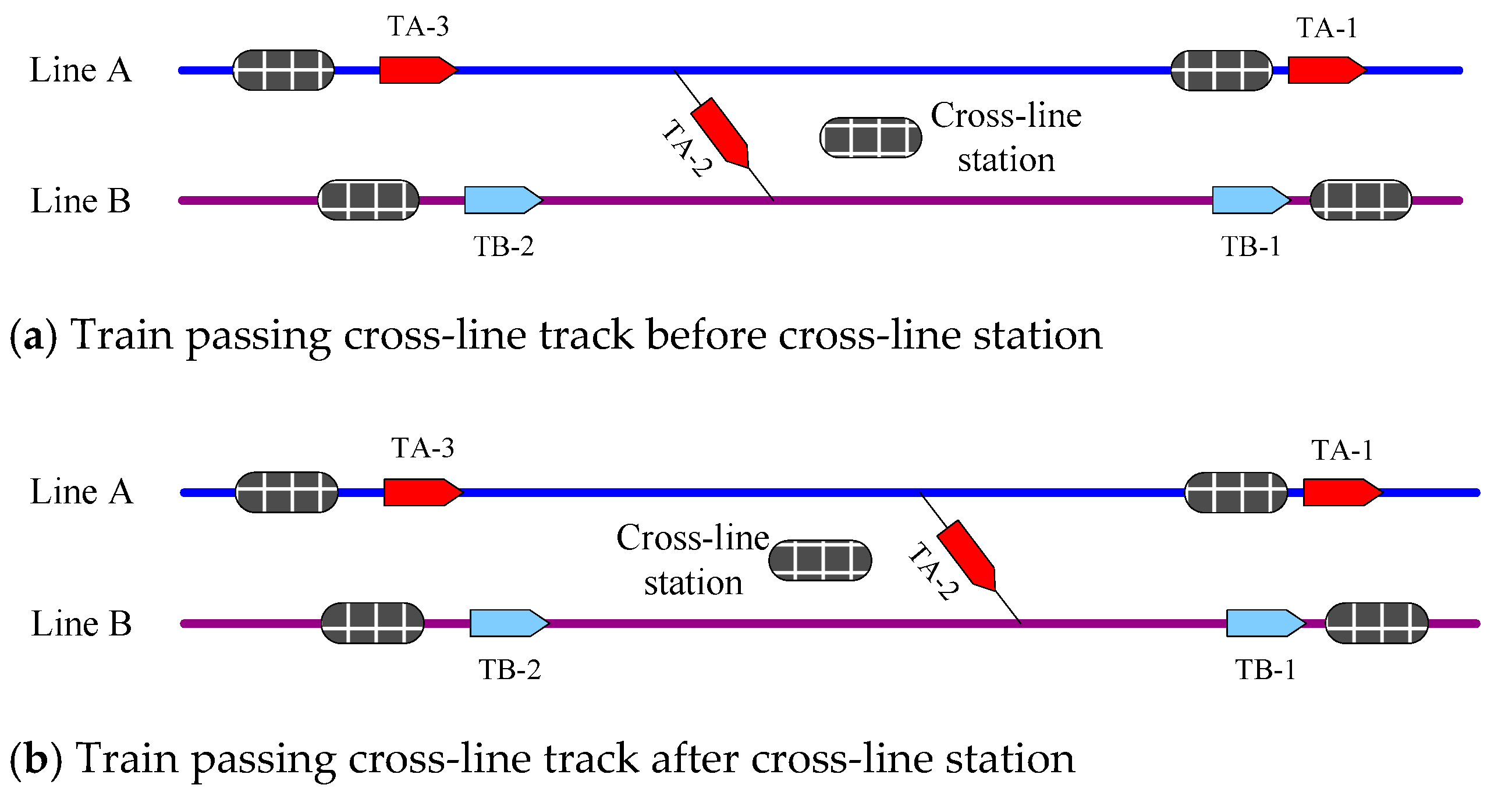
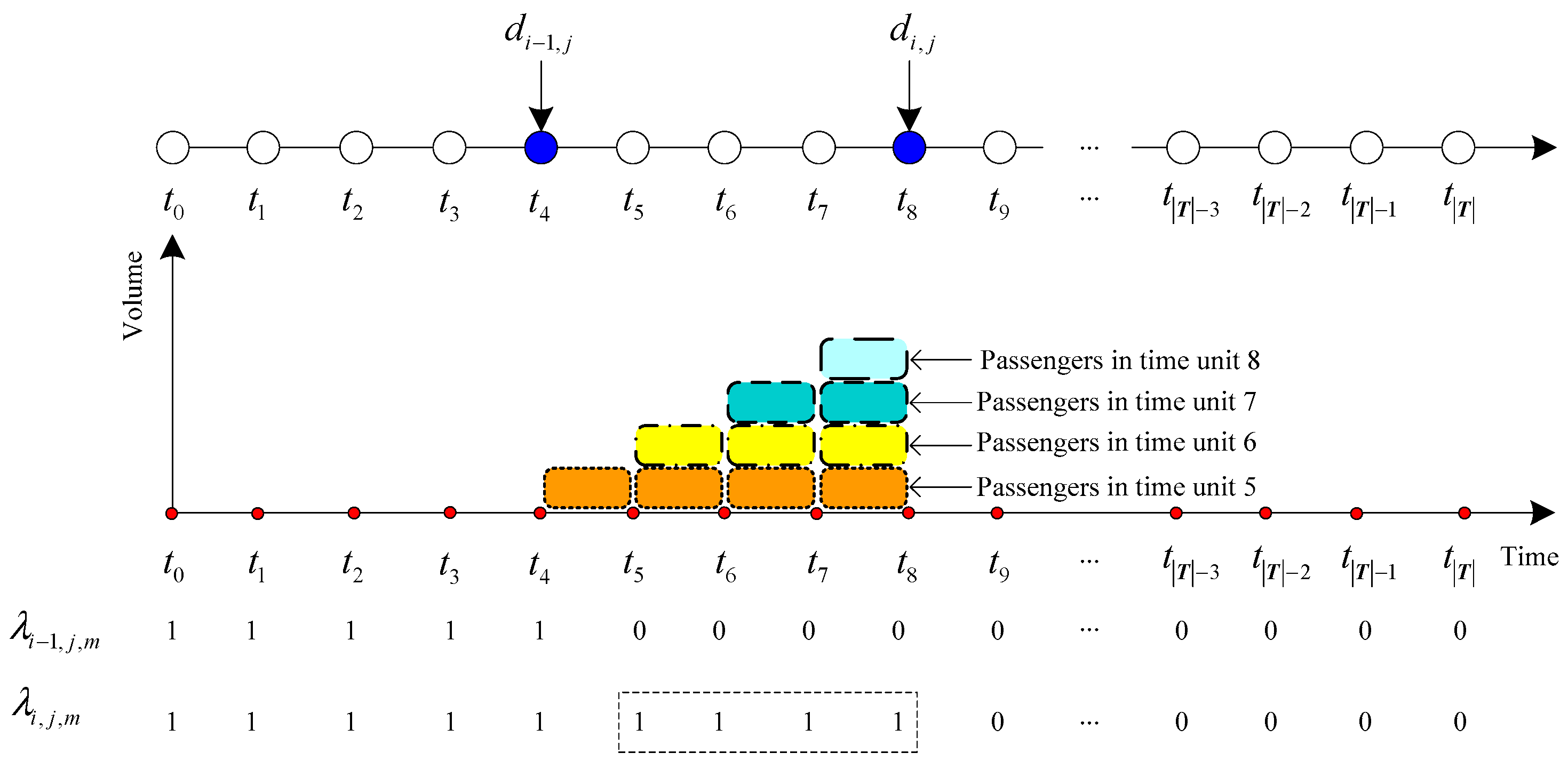
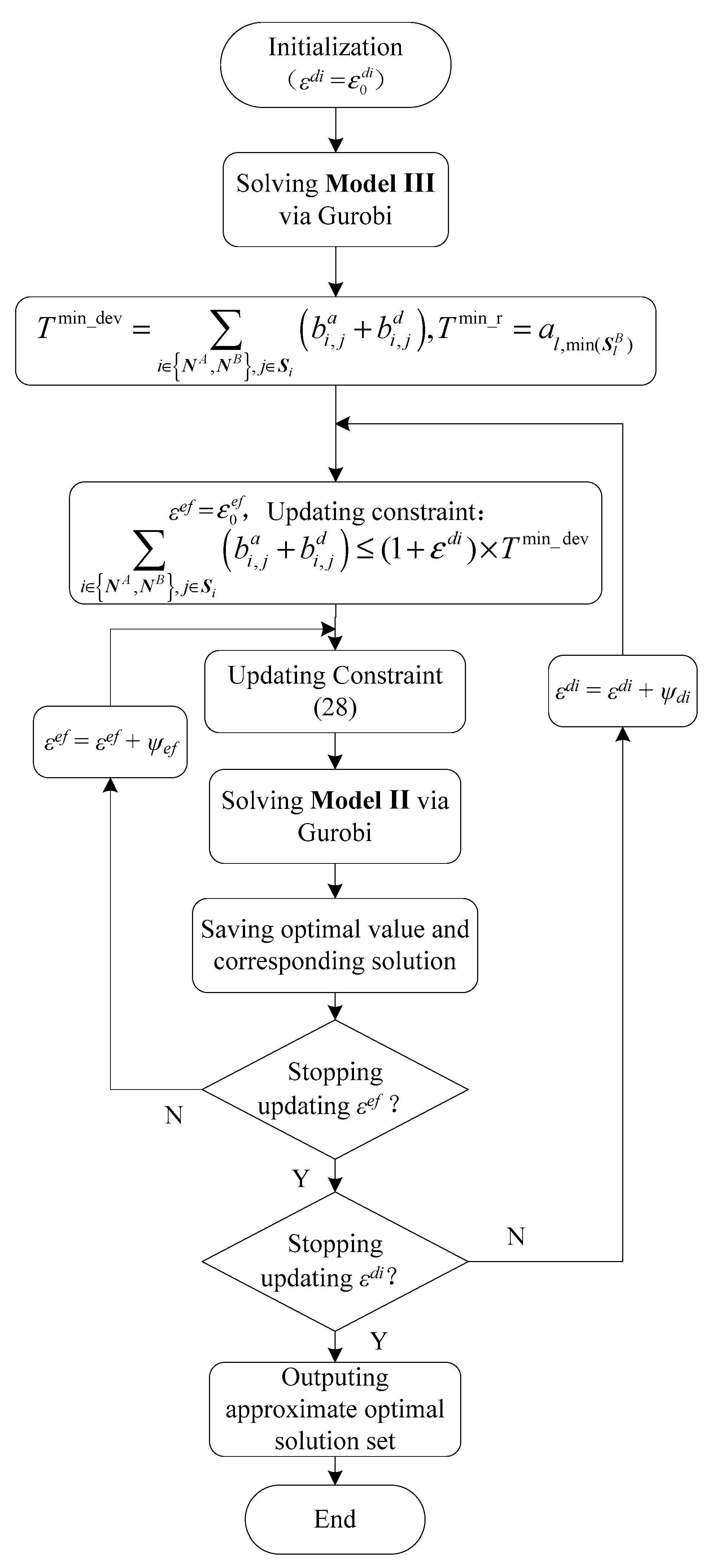

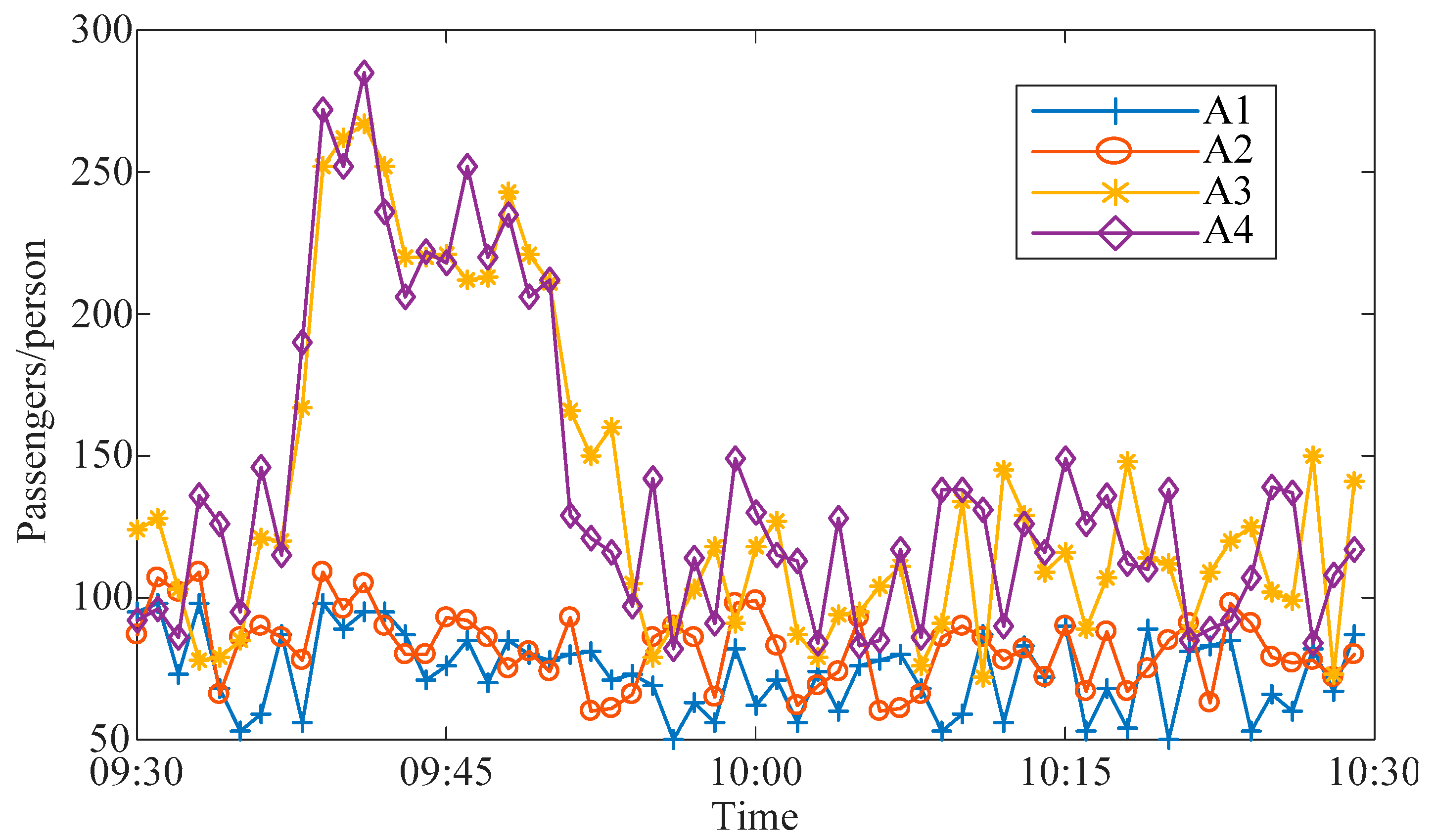



| Station | A2 | A3 | A4 | A5 | A6 | A7 | A8 | A9 | A10 | A11 | A12 | A13 | A14 | A15 |
|---|---|---|---|---|---|---|---|---|---|---|---|---|---|---|
| A1 | 0.034 | 0.034 | 0.037 | 0.332 | 0.044 | 0.047 | 0.050 | 0.052 | 0.055 | 0.058 | 0.062 | 0.063 | 0.065 | 0.067 |
| A2 | -- | 0.015 | 0.013 | 0.615 | 0.024 | 0.026 | 0.030 | 0.033 | 0.036 | 0.039 | 0.029 | 0.045 | 0.048 | 0.047 |
| A3 | -- | -- | 0.008 | 0.816 | 0.011 | 0.013 | 0.014 | 0.016 | 0.017 | 0.019 | 0.021 | 0.022 | 0.020 | 0.023 |
| A4 | -- | -- | -- | 0.725 | 0.018 | 0.020 | 0.023 | 0.025 | 0.028 | 0.030 | 0.033 | 0.033 | 0.034 | 0.031 |
| A5 | -- | -- | -- | -- | 0.062 | 0.070 | 0.078 | 0.087 | 0.096 | 0.104 | 0.113 | 0.122 | 0.129 | 0.139 |
| A6 | -- | -- | -- | -- | -- | 0.065 | 0.073 | 0.082 | 0.089 | 0.097 | 0.124 | 0.141 | 0.156 | 0.173 |
| A7 | -- | -- | -- | -- | -- | -- | 0.073 | 0.081 | 0.089 | 0.097 | 0.132 | 0.154 | 0.176 | 0.198 |
| A8 | -- | -- | -- | -- | -- | -- | -- | 0.088 | 0.097 | 0.105 | 0.139 | 0.164 | 0.191 | 0.216 |
| A9 | -- | -- | -- | -- | -- | -- | -- | -- | 0.121 | 0.131 | 0.143 | 0.172 | 0.202 | 0.231 |
| A10 | -- | -- | -- | -- | -- | -- | -- | -- | -- | 0.221 | 0.147 | 0.179 | 0.211 | 0.242 |
| A11 | -- | -- | -- | -- | -- | -- | -- | -- | -- | -- | 0.189 | 0.229 | 0.271 | 0.311 |
| A12 | -- | -- | -- | -- | -- | -- | -- | -- | -- | -- | -- | 0.283 | 0.334 | 0.383 |
| A13 | -- | -- | -- | -- | -- | -- | -- | -- | -- | -- | -- | -- | 0.465 | 0.535 |
| A14 | -- | -- | -- | -- | -- | -- | -- | -- | -- | -- | -- | -- | -- | 1 |
| Timetable | Transfer Passengers Served/Person | Remaining Capacity/Person 1 | Transfer Passengers on Planned Trains/Person | Maximum Stranded Passengers/Person | |||||||||
|---|---|---|---|---|---|---|---|---|---|---|---|---|---|
| Ta2 | Ta3 | Ta4 | Ta5 | Ta6 | Ta7 | Ta8 | A1 | A2 | A3 | A4 | |||
| Rescheduled timetable | 836 | 484 | 556 | 476 | 605 | 438 | 483 | 440 | 428 | 0 | 0 | 0 | 170 |
| Original timetable | -- | -- | 556 | 669 | 558 | 596 | 556 | 550 | 428 | 0 | 0 | 0 | 1001 |
Disclaimer/Publisher’s Note: The statements, opinions and data contained in all publications are solely those of the individual author(s) and contributor(s) and not of MDPI and/or the editor(s). MDPI and/or the editor(s) disclaim responsibility for any injury to people or property resulting from any ideas, methods, instructions or products referred to in the content. |
© 2023 by the authors. Licensee MDPI, Basel, Switzerland. This article is an open access article distributed under the terms and conditions of the Creative Commons Attribution (CC BY) license (https://creativecommons.org/licenses/by/4.0/).
Share and Cite
Yuan, J.; Zhao, X.; Chu, P. Train Rescheduling for Large Transfer Passenger Flow by Adding Cross-Line Backup Train in Urban Rail Transit. Appl. Sci. 2023, 13, 11228. https://doi.org/10.3390/app132011228
Yuan J, Zhao X, Chu P. Train Rescheduling for Large Transfer Passenger Flow by Adding Cross-Line Backup Train in Urban Rail Transit. Applied Sciences. 2023; 13(20):11228. https://doi.org/10.3390/app132011228
Chicago/Turabian StyleYuan, Jianjun, Xiaoqun Zhao, and Pengzi Chu. 2023. "Train Rescheduling for Large Transfer Passenger Flow by Adding Cross-Line Backup Train in Urban Rail Transit" Applied Sciences 13, no. 20: 11228. https://doi.org/10.3390/app132011228






